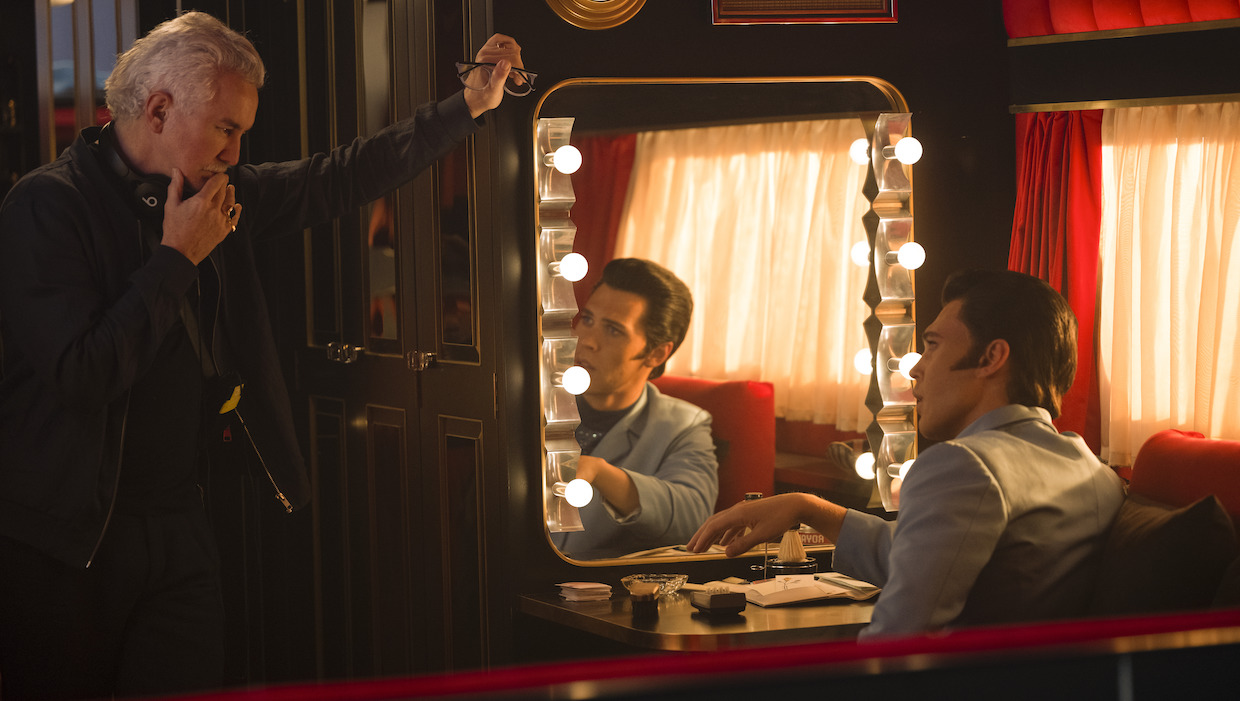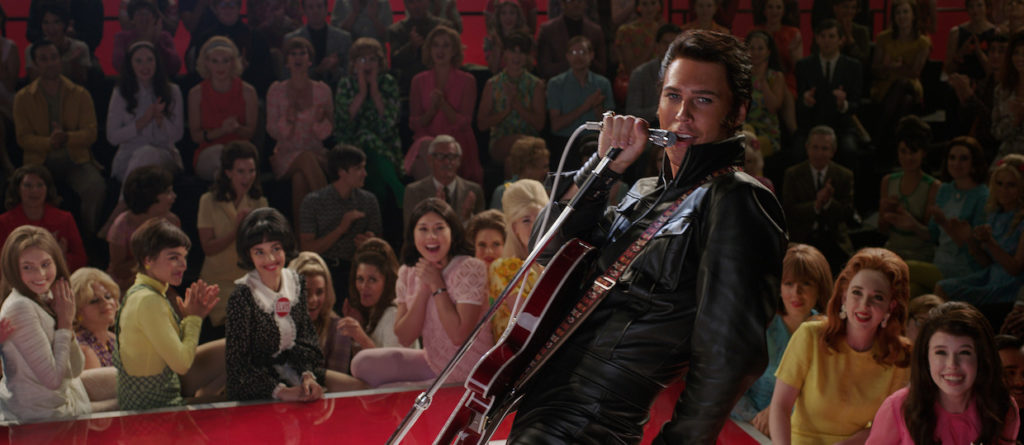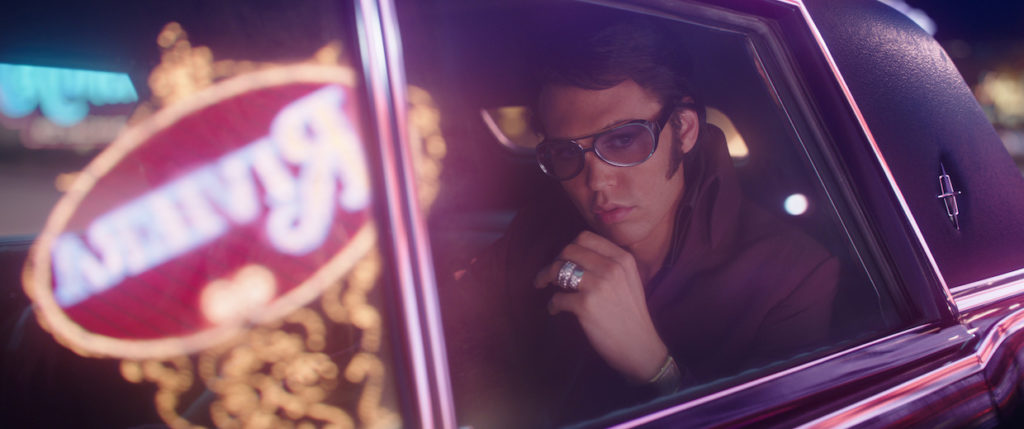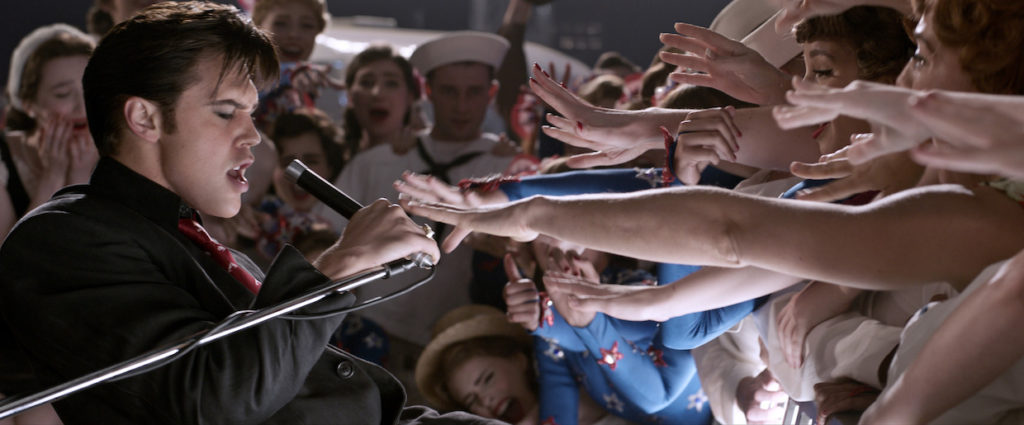 Back to selection
Back to selection
Shutter Angles
Conversations with DPs, directors and below-the-line crew by Matt Mulcahey
“Elvis’s Eyes Were Very Special”: DP Mandy Walker on Elvis
 Baz Luhrmann and Austin Butler on the set of Elvis (photo: Kane Skennar)
Baz Luhrmann and Austin Butler on the set of Elvis (photo: Kane Skennar) While the use of larger format sensors like the Alexa LF and the Sony Venice has continued to accelerate—increasingly eclipsing Super35 as the default for robustly budgeted digital cinematography—the sprawling canvas offered by the Alexa 65 has remained more of a specialty, employed by projects seeking a scope of particularly monumental proportions.
That’s exactly how cinematographer Mandy Walker envisioned Baz Luhrmann’s Elvis.
“I remember Baz and I talking about the film really early on and thinking, ‘This character is larger than life,’” said Walker, who also used the Alexa 65 on Mulan and The Mountain Between Us. “Elvis was epic, and what better way to express that than shooting on the most epic format you can?”
Shot almost entirely on the backlots and soundstages of Australia’s Village Roadshow Studios, Luhrmann imagines Elvis as a “three-act pop-cultural opera”, a trajectory that covers decades of the rock and roll progenitor’s life. With the movie now in theaters, Walker spoke to Filmmaker about creating distinct looks for each of The King’s phases, from his Tupelo, Mississippi childhood to his final days trapped in an ivory Las Vegas tower.
Filmmaker: I’m going to start by putting you on the spot. Is there one image or scene in Elvis that encapsulates what you love about the Alexa 65?
Walker: I would say the Vegas showroom [at the International Hilton, where Elvis spent many years in residency late in his life]. When the big gold curtain comes up and you see Elvis on stage in the Hilton Ballroom, the Alexa 65 brilliantly captures the expanse of it. The 65 can give you those epic widescreen landscapes, but it can also be very intimate for close-ups because it has such a shallow depth of field.
Filmmaker: I was reading an interview you did back when Mulan came out where you talked about working with Dan Sasaki at Panavision to individualize your lenses. For that movie, you showed him a painting and said, “That’s what I want our landscapes to look like.” You shot the pre-Vegas section of Elvis on Spheros, then went anamorphic for the latter half of the film with the T Series. What was the process of selecting—and then tweaking—those lenses with Dan?
Walker: I took Baz in with me. I started talking to Baz about the movie in July of 2019. He was in L.A, so I said, “We’re going to go and visit Dan.” I’d called Dan before we came in and said, “It’s Elvis and we want to represent him—and the different periods of American culture—through the ’50s, ’60s and ’70s.” When Baz and I arrived, Dan already had six different types of lenses set up. Some were on 35mm and some were on a 65mm camera. He started asking us questions about how we saw the color and the contrast of these different periods of time. Dan came up with three iterations for us. The first and second were not quite right, but the third lot of lenses that he built, which we tested with [Elvis portrayer] Austin Butler on stage in costumes, felt like they were the right tool for the visual language of the film.
Filmmaker: You also used Petzval lenses. Was that mainly for the Colonel Tom Parker [Tom Hanks] framing device and flashbacks?
Walker: The Colonel is on morphine [during the time period of the framing device] so, when he’s relaying his story, there are certain sequences where we put the Petzval on for that. We also used it at the beginning of the film where Elvis collapses in the corridor behind the showroom at the Hilton Hotel and for some of the other dreamlike sequences or flashbacks that were related to drug episodes. I had an anamorphic and a spherical version of the Petzval that Dan made specifically for us. With the Petzval lenses, you can have a lot of variation in the vignetting, how much of the out-of-focus background you can create and how much of the center of the frame is in focus. Again, we did tests for that to get it just right.

Filmmaker: This is a film that Baz has been working on for ten years. What references had he put together when you came on board?
Walker: He had collected amazing references from the difference periods and of Elvis, even some of his home movies. There were a couple of very specific performances that we looked at that Baz wanted to reproduce exactly. He called those “trainspotting” sequences. One of them was the 1968 NBC special, and the other was a documentary of Elvis when he first went to Vegas called That’s the Way It Is. For the Vegas showroom, we studied the camera positions and actual lighting set-ups meticulously and reproduced everything—the color, the lighting changes, when the follow spot moved from here to there, when the backdrop changed color. So, we spent a lot of time in prep just doing this meticulous preparation. I was also looking up stills photographers from the periods. There was a still photographer, Alfred Wertheimer, who traveled with Elvis during the 1950s. So, I had all these images in the back of my mind, then you add in all these other elements—the art department, costumes and hair and make-up—and they all come together in harmony to become the visual language of the film.
My DIT Sam Winzar, who is amazing, was a very important part of this whole process as well. We would set LUTs for the different periods and locations and were very specific about that. We did a lot of testing. [During principal photography] I would go in at night with my DIT and sit with the dailies colorist and tweak a little bit and balance all the cameras out so everything flowed a little bit better.
Filmmaker: Elvis’ first performance in the movie is singing “That’s All Right” on the Louisiana Hayride. It’s pretty early in Elvis’s career. Were there any historical references for that show?
Walker: There were some still photographs, because the Hayride was quite a famous tour that happened every year. We actually scoured the country for old rock and roll and theatrical lights so that the lights that you see in the frame were real lights of the period. Then, of course, we added our own modern lighting to augment it, especially LEDs so that we’d have full color control. That scene was a little bit brighter than some of the other concert sequences. We really see the audience because they’re in a town hall, not a concert stadium, and we wanted to represent the feeling of that.

Filmmaker: What is that row of footlights (seen in the frame above) at the front of the stage? We see those again at Elvis’ Russwood Park concert. Are those period lights you found?
Walker: We built them, but they are period appropriate.
Filmmaker: What units did you actually put behind those glass coverings?
Walker: We used BB&S Area 48 Color LED soft lights so we could have full control and so that the lights were not as hot as traditional 1K tungsten theatrical ground rows. That allowed the crowd to lean on, fall on and climb over the lights without getting burnt. We asked the art department to build a box around them in the style of the era. They looked exactly like what we saw in old footage.
Filmmaker: How did you design the coverage for that concert? How many cameras did you use?
Walker: We had four cameras and I think we shot there for three days. One day we’d be backstage, one day we’d be on the side of the stage, then one day we’d be in front of the stage. That was such an important show for the drama of the movie, with the Colonel up in the gantry on the side of the stage watching Elvis. It’s also where you really see the reaction of the audience to him performing. It was all meticulously planned and rehearsed during prep. Baz does storyboards, but all the concerts were dress rehearsed with the cameras in prep quite a few times to plan out all the shots. During the rehearsals Baz and I would stand there with the four monitors in front of us making adjustments to the shots.
Filmmaker: Is that scene shot in a practical theater?
Walker: No, none of the theaters are practical. It was shot on a stage.
Filmmaker: The wide shot of the crowd from the stage POV, that’s a digital set extension?
Walker: Yes, it is.
Filmmaker: It passes really well.
Walker: We had about 300 people in the crowd. So, that would be like the first third of the theater, then the back was filled in by visual effects. They did an amazing job. They’d spend days in each set with the second unit moving the crowd around and shooting plates to do crowd reproduction. Everything in the movie was shot on stage except for four backlot sequences, which were Shake Rag in Tupelo with young Elvis, the exterior of Graceland, the carnival and Beale Street. One great thing about working with Baz and [producer/production designer] Catherine Martin is that most of the set is physically there and we’re just extending here and there in the deep background.

Filmmaker: I love the close-ups in this movie. They are absolutely beautiful, with incredible eye lights for Austin Butler.
Walker: Elvis’s eyes were very special. He had these very charismatic eyes. We had a few different types of eye lights that we used in the movie. We had the ground row [footlights] in some of the concert sequences. In the barbershop sequence [where Elvis gets his hair cut before joining the Army] we had photographers’ flashbulbs going off, both practical ones and ones that we put in ourselves. Then I always had this eye light stick that Shaun Conway, my gaffer, made. It was made very specifically for this film. It was about a foot-long cone with lite ribbon inside covered in diffusion, like a covered wagon. Shaun’s best boy would have it on a boom and follow the camera. So, if we were moving the camera, he would come in underneath the lens with that light. It was so soft that it didn’t change the lighting, but it reflected in the actors’ eyes. Our best boy was a master at getting it in the right spot.

Filmmaker: Let’s finish up with the Russwood Park concert, which is the end of the 1950s section of the film.
Walker: We were going to shoot that outside, but at the time of year that we were looking at filming, Queensland has a tropical system where it rains a lot. And when it rains, it rains for like three weeks. So, we ended up bringing it inside on stage. We shot on one of the biggest stages they had at Village Roadshow. To create the look of being in a stadium, we made these big stadium tower lights that were made of Nine-lights joined together so they could be in shot. I lit for 360 degrees, but we would adjust the backlight for whatever direction we were facing.
Filmmaker: There are a few black-and-white shots meant to be footage from the Vice Squad, who are there to monitor Elvis’ gyrations. There’s one particular image I remember that’s shot from behind the stage looking out. Elvis is raised up on his toes at the front of the stage, surrounded by the audience.
Walker: That was a very direct reference to one of the Alfred Wertheimer photos. He shot some Super 16 black and white and he shot some stills photographs from Russwood and that is pretty much an exact replica of one of his shots.
Filmmaker: The scene ends with Elvis being taken away in a police car. He looks up through the back window and there’s a reflection of fireworks on the glass. It’s this splash of color that takes us from the very monochromatic 1950s to the 1960s.
Walker: That’s exactly what it is. I love it that you noticed that transition. What I always try to do before a movie is have these kind of things worked out. So, Catherine Martin and I looked at photographs so we could figure out what color the fireworks would’ve been in the ‘50s, then worked out the details with the visual effects team. In that shot, Austin is lit by SkyPanel 360s and S60s changing colors that we placed outside the car, then that’s a visual effect on top of the glass for the actual fireworks.
